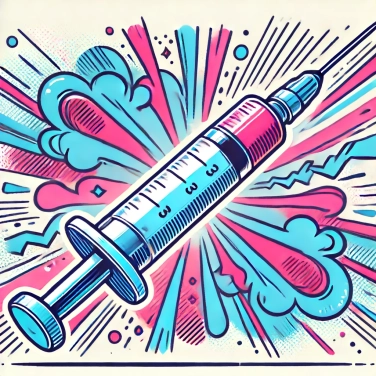The fine needles of insulin syringes are necessary because insulin must be injected under the skin (subcutaneous injection) and not into the muscle. The fine needles minimize pain and the risk of bleeding, making self-administration easier for diabetic individuals.

When injecting insulin, it must be delivered precisely subcutaneously, just under the skin. A very fine needle allows for more accurate administration at this level, without penetrating too deeply into the muscle. Injecting into the muscle would cause the insulin to be absorbed too quickly, which can lead to dangerous hypoglycemia. A fine needle also helps limit insulin leakage after the injection, thus ensuring an exact dose. In short, with these fine needles, we perfectly target the ideal spot for the insulin to work well and at the right pace in the body.
Fine needles are mainly a matter of comfort. With very fine needles, the sting is felt much less because they significantly reduce pain. A thick needle tears more tissue, catches the skin more, which obviously hurts—while a very fine one glides through gently. The fineness also limits skin trauma by reducing the size of the opening in the skin, resulting in less damage, fewer scars, and fewer little bruises after the injection. It's practical when you need to inject yourself several times a day, right? Studies clearly show: the finer the needle, the better it is tolerated, especially by those who have a panic fear of needles!
Very fine needles for insulin help to measure each dose with more precision and consistency. With a needle that is too thick, there is a risk of having a drop of insulin that gets stuck or comes out poorly, causing the final injected amount to vary. A finer needle especially allows for precise control of the flow and ensures that all the injected insulin actually enters under the skin. Less waste, fewer surprises, better dosing.
In recent years, the manufacturing of insulin needles has benefited from interesting innovations. Technologies like electrochemical polishing allow for an extremely even and very fine tip, minimizing the pain felt. We have also seen the introduction of specific silicone coatings, which make injections smoother and reduce friction during skin penetration. Another cool advancement is the availability of ultra-short needles, now measuring just 4 mm, offering better comfort and reducing the risk of overly deep injections. Some manufacturers are even working on special designs that further improve dosage accuracy while significantly reducing the discomfort associated with repeated injections. In short, these technological advancements are clearly changing the daily lives of people with diabetes by making insulin administration less burdensome.
The needles intended for insulin injection adhere to very strict standards: their tip is specifically beveled to enhance skin penetration and minimize the pain felt.
Before the discovery of insulin in the 1920s, type 1 diabetes was considered an incurable disease, and the treatments available at that time were very limited.
The very fine needles used today for insulin injections generally measure between 4 mm and 8 mm, a length deemed ideal for minimizing pain and enhancing comfort during the injection.
Insulin is injected under the skin (subcutaneous injection) because its absorption is more consistent and effective at this location than directly into the muscles or blood vessels.
Yes, you can adopt certain practices that further reduce the sensation of pain, such as injecting insulin slowly, slightly adjusting the angle of injection, avoiding muscles and sensitive areas, or possibly applying light pressure on the skin before the injection.
Each insulin needle is designed for single use. Reusing needles increases the risk of infections, pain, and affects the integrity of the needle, which can make injections uncomfortable. Therefore, it is recommended to replace them each time.
The thickness of the needle itself does not directly influence the speed of insulin absorption. However, a thin needle facilitates a proper subcutaneous injection (by avoiding accidental intramuscular injections), which can positively affect the consistency and regularity of absorption.
The length of the needle to choose generally depends on your body type, the amount of body fat, and the injection site. For the majority of adults, a shorter needle (4 to 6 mm) is usually recommended as it limits the risk of injecting into the muscles while reducing pain.
Although fine needles may indeed seem fragile, most current insulin needles are designed with robust, flexible, and durable materials that significantly minimize any risk of bending or breaking under normal use conditions.

No one has answered this quiz yet, be the first!' :-)
Question 1/5